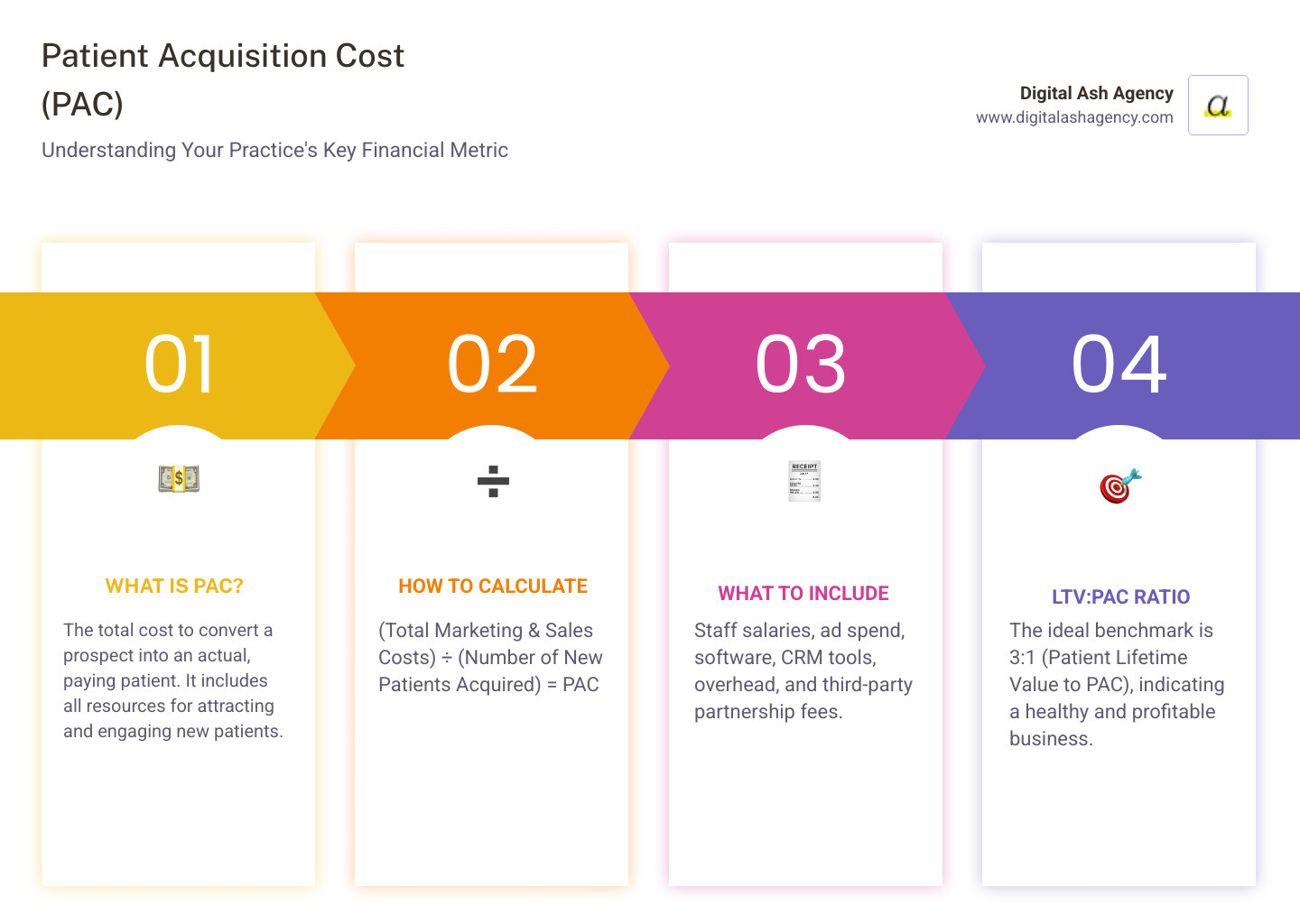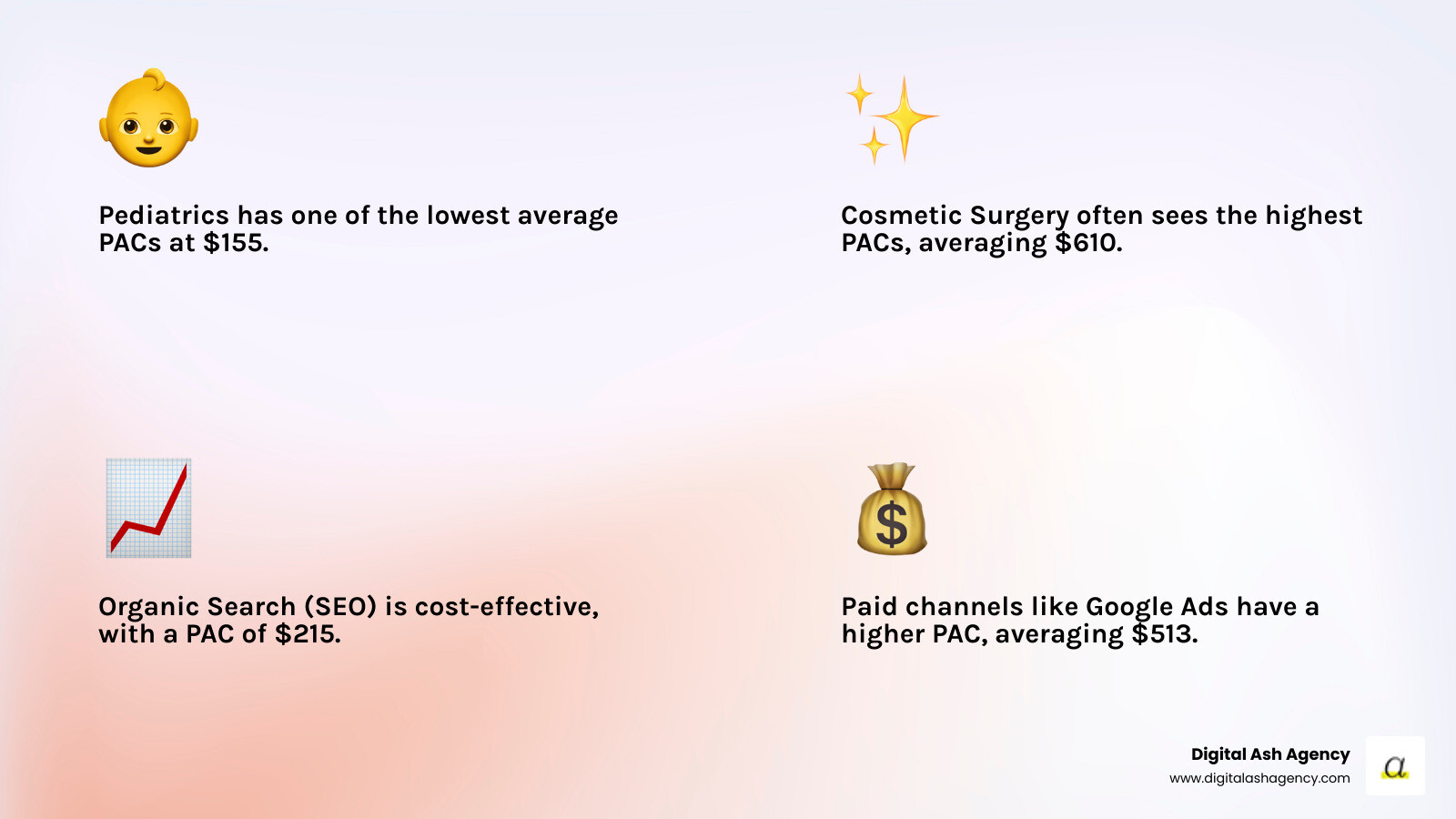
Why Patient Acquisition Cost Is Your Practice's Most Important Financial Metric
Patient acquisition cost (PAC) is the total amount your healthcare practice spends to convert a prospect into a paying patient. It's calculated by dividing your total sales and marketing expenses by the number of new patients acquired in a specific period.
Quick PAC Calculation:
- Formula: Total Marketing & Sales Costs ÷ Number of New Patients = PAC
- Healthy Benchmark: 3:1 patient lifetime value to PAC ratio
- Industry Average: Ranges from $155 (Pediatrics) to $610 (Cosmetic Surgery)
- Goal: Keep PAC significantly lower than patient lifetime value
If you've ever invested in a marketing strategy that yielded minimal return, you know how frustrating it can be. Understanding your PAC is about making smart financial decisions that drive sustainable growth, especially when facing non-compete restrictions or limited marketing reach.
Knowing your PAC helps you determine profitability per patient, identify high-ROI marketing channels, and allocate your budget effectively. The stakes are high, as many executives feel marketers don't focus enough on results that drive new patient demand. You need concrete data to justify every marketing dollar.
I'm Ashley Gay, a branding expert who helped my husband's independent medical practice generate $239K in revenue in its first 90 days and nearly $1 million in the first year. We did this by strategically managing Patient acquisition cost and focusing on what works. My experience has proven that understanding and optimizing PAC is the foundation of sustainable practice growth.

What is Patient Acquisition Cost (PAC) and Why Does It Matter?
Think of Patient acquisition cost as your practice's financial GPS. It's the total cost to bring a new patient through your doors. At its core, PAC represents every dollar spent to turn a stranger into a paying patient, including all marketing and sales investments. In many ways, it parallels the broader advertising metric known as cost per acquisition, but it is custom specifically to healthcare where the end goal is a paying patient rather than a one-time sale.
Defining PAC in Healthcare
While you may have heard of Cost Per Lead (CPL) or Cost Per Appointment (CPA), these metrics don't tell the whole story. CPL measures interest, and CPA tracks scheduled appointments. Patient acquisition cost is different—it measures the cost to acquire a paying patient who generates real revenue. This distinction is crucial because it directly connects marketing spend to your bottom line, ensuring you focus on a positive return on investment.
The Importance of Tracking PAC
Many practices operate without a clear understanding of their Patient acquisition cost, essentially flying blind with growth investments. Tracking PAC is transformative for several reasons:
- It reveals your true financial health. A busy practice isn't always a profitable one. If your PAC is higher than your patient lifetime value, you're losing money on each new patient.
- It empowers strategic decisions. Knowing that referrals cost $50 per patient while Facebook ads cost $400 makes your marketing priorities clear. You can invest in what works and cut what doesn't.
- It identifies high-performing channels. PAC data helps you spot which channels, like local physician partnerships or your website, deliver quality patients cost-effectively.
- It ensures sustainable growth. By keeping your Patient acquisition cost well below your patient lifetime value, you build a foundation for long-term success, avoiding the financial stress that can accompany rapid, uninformed expansion.
According to a widely cited study, 73% of executives in the United States don't believe marketers focus enough on results that actually drive business growth. Don't be another statistic. Understanding and optimizing your Patient acquisition cost puts you in control of your marketing investments and positions your practice for profitable expansion.
How to Calculate Your Patient Acquisition Cost
Calculating your Patient acquisition cost requires attention to detail but is essential for understanding your practice's financial health.

The Core PAC Formula
The basic formula is simple:
PAC = Total Sales & Marketing Costs ÷ Number of New Patients Acquired
For example, if your practice spent $15,000 on marketing last quarter and acquired 75 new patients, your PAC would be $200 ($15,000 ÷ 75). The key is to be consistent with your calculation period (monthly, quarterly, or annually) and comprehensive in what costs you include.
What Expenses to Include in Your Calculation
To get an accurate Patient acquisition cost, you must account for every dollar that contributes to acquiring new patients. A common mistake is to only count obvious ad spend. A true calculation includes:
- Salaries and Wages: Include salaries, benefits, and wages for all staff involved in marketing and patient acquisition, from marketing coordinators to front desk staff and contractors.
- Advertising Spend: This covers all paid media, including digital ads (Google, social media), direct mail, and traditional ads (radio, print).
- Software Costs: Factor in your CRM, email marketing platform, call tracking software, and analytics tools.
- Third-Party Partnerships: Include fees for marketing agencies, referral services, or lead generation companies.
- Overhead: A portion of overhead costs, like office space or phone systems used by the marketing team, should also be included.
Including all these expenses gives you a realistic picture of your PAC and a clearer understanding of where your money is going.
The LTV to PAC Ratio: The Key to Profitability
Your Patient acquisition cost is most powerful when compared to your Patient Lifetime Value (LTV)—the total revenue a patient generates over their entire relationship with your practice.
The 3:1 LTV to PAC ratio is the gold standard for a healthy practice in the United States. For every $1 you spend acquiring a patient, you should earn at least $3 back.
- A ratio below 3:1 is a red flag that you're paying too much per patient.
- A ratio above 5:1 might mean you're under-investing in marketing and missing growth opportunities.
This ratio is your North Star for making smart decisions about marketing budgets and growth strategies, ensuring your practice remains profitable and sustainable.
Healthcare PAC Benchmarks: How Do You Compare?
Understanding where your practice stands against industry averages is eye-opening. Patient acquisition cost varies significantly across specialties and marketing channels. These U.S. benchmarks can guide your budget allocation and goal-setting.

Average Patient Acquisition Cost by Practice Type
A "good" Patient acquisition cost depends heavily on the specialty. Our analysis of U.S. practices (2019-2024) shows a wide range:
- Pediatrics: $155 (driven by referrals and long-term relationships)
- General Practice: $203
- Family Practice: $277
- Urgent Care: $287 (benefits from immediate patient need)
- Dentistry: $374
- Dermatology: $441
- Orthodontics: $520
- Cardiology: $577
- Neurology: $582
- Cosmetic Surgery: $610 (reflects elective procedures and a competitive market)
These differences are due to factors like patient lifetime value, competition, and the nature of the services offered.
Average Patient Acquisition Cost by Marketing Channel
The channel you use to reach patients dramatically impacts your costs. Analysis of U.S. healthcare campaigns reveals clear trends:
- Organic Search (SEO): $215 (high-intent patients, excellent long-term ROI)
- Direct Mail: $240
- Email Marketing: $256
- Organic Social Media: $289
- Paid Social Media: $291
- Paid Search (PPC): $342
- Radio Advertising: $380
- Outdoor Advertising: $412
- TV Advertising: $461
- Google Ads (Specific Campaigns): $513 (reflects high competition for keywords)
While channels like SEO offer the best value, a strategic mix often yields the best results. A pediatric practice might focus on SEO and referrals, while a cosmetic surgery clinic may need higher-cost channels to reach its target audience.
6 Actionable Strategies to Lower Your Patient Acquisition Cost
Knowing your PAC is the first step; reducing it is the goal. These strategies will help make every marketing dollar work harder for your practice.

1. Improve Patient Experience and Retention
It's a foundational principle of U.S. business strategy that acquiring a new patient costs five times more than keeping an existing one. Therefore, one of the best ways to lower your Patient acquisition cost is to focus on retention. Exceptional patient experiences turn current patients into your best marketing team. Focus on every interaction, from the initial phone call to the waiting room environment. Use Net Promoter Score (NPS) surveys to gather feedback and identify areas for improvement. Also, explore cross-sell and upsell opportunities to increase patient lifetime value without additional acquisition spend.
2. Optimize Your Digital Presence and Conversion Rates
Many practices waste marketing dollars by driving traffic to websites that don't convert. Conversion Rate Optimization (CRO) is key to fixing this. Analyze how visitors interact with your site and use A/B testing on headlines, buttons, and forms to see what works best. Ensure your landing pages have a clear purpose, a single call-to-action, and load quickly on mobile devices. A better-converting website directly lowers your Patient acquisition cost.
3. Streamline the Patient Journey
A difficult scheduling process can drive potential patients to competitors. Online scheduling is no longer a luxury; it's an expectation for patients of all ages. It removes a significant barrier by allowing 24/7 booking. Also, evaluate your phone experience. Long hold times lead to abandoned calls. Use call tracking to identify issues and implement solutions like a callback system. Every improvement that reduces friction in the patient journey will boost your conversion rate.
4. Focus on High-ROI Channels like Referrals and SEO
Not all marketing channels are equal. Referrals are a top acquisition source in healthcare because they come pre-qualified and with built-in trust. Develop a referral management process by nurturing relationships with other providers and encouraging patient-to-patient referrals through excellent care. SEO is another cost-effective powerhouse, with an average PAC of just $215. While it takes time, patients who find you via search are actively seeking your services. Support your SEO with content marketing that answers patient questions and builds your authority.
5. Refine Targeting with Patient Personas
Marketing without patient personas is like shooting in the dark. Develop detailed profiles of your ideal patients, including demographic and psychographic data. By understanding the needs and characteristics of your most engaged patients, you can craft personalized messaging that addresses their specific concerns. This targeted approach ensures you reach the right people, improving conversion rates and naturally lowering your Patient acquisition cost.
6. Use Technology and Automation
Marketing automation and CRM software are essential for efficient patient acquisition. Automation handles repetitive tasks like email nurturing and appointment reminders, freeing up your staff. A CRM tracks every patient interaction, helping you understand which marketing efforts are working. At Digital Ash Agency, we offer CRM Solutions designed for healthcare to streamline patient management. By automating workflows and reducing manual tasks, technology makes your acquisition campaigns more efficient, scalable, and profitable.
Common Challenges in Measuring and Optimizing PAC
Tracking your Patient acquisition cost isn't always simple. Healthcare practices face unique problems that can make accurate measurement difficult, but these challenges are manageable.

Challenge 1: Inaccurate Cost and Attribution Tracking
The Problem: A patient might interact with your practice through multiple channels (e.g., a Facebook ad, a friend's referral, and a Google search) before booking. It's hard to know which channel gets the credit, making it difficult to calculate an accurate Patient acquisition cost for each channel.
The Solution:
- Comprehensive Expense Logging: Track every marketing dollar.
- Call Tracking: Use unique phone numbers for different campaigns to see what drives calls.
- Intake Forms: Consistently ask, "How did you hear about us?" to spot trends.
- Unique URLs: Assign specific URLs to referral partners or offline campaigns to track their effectiveness.
Challenge 2: The Extended Patient Journey
The Problem: The decision-making process for healthcare, especially for specialized services, can take weeks or months. This makes it hard to connect a marketing effort from one budget cycle to a conversion that happens in another.
The Solution:
- Robust CRM System: Use a CRM to track every prospect interaction over time, giving you a complete view of the patient journey.
- Lead Nurturing: Implement automated email sequences and content to keep your practice top-of-mind during long decision cycles.
- Acknowledge Differences: Understand that an urgent care visit has a much shorter journey than a major surgery and adjust your tracking expectations accordingly.
Challenge 3: Lack of In-House Marketing Expertise
The Problem: Most healthcare providers are medical experts, not marketing analysts. This expertise gap can lead to either over-complicating PAC measurement or over-simplifying it to the point of being useless.
The Solution:
- Focus on Core Metrics: Master the basic PAC formula and the LTV:PAC ratio. These two metrics provide the most critical insights.
- Regular Business Planning: Make PAC analysis a routine part of your monthly or quarterly business reviews.
- Partner with Specialists: For many practices, the most practical solution is to partner with a healthcare marketing agency that understands the U.S. market and the nuances of patient acquisition metrics.
With the right tools and approach, you can turn Patient acquisition cost from a confusing metric into a powerful tool for growth.
Conclusion
Strategically managing your Patient acquisition cost is the compass that guides your practice toward sustainable growth. It provides the clarity needed to steer the complex world of healthcare marketing with confidence.
We've covered how to calculate PAC, the importance of the 3:1 LTV to PAC ratio, and how U.S. industry benchmarks can inform your strategy. The actionable strategies—from improving patient retention and optimizing your digital presence to focusing on high-ROI channels like SEO—provide a clear roadmap to a more efficient and profitable acquisition system.
While challenges like attribution tracking and long patient journeys are real, they are solvable. You don't have to figure it out alone.
At Digital Ash Agency, we've seen how mastering Patient acquisition cost transforms practices. Knowing your numbers allows you to make marketing decisions with confidence, not guesswork. Your practice deserves the clarity and efficiency that comes from a data-driven approach, ensuring your marketing dollars work as hard as you do.
Ready to take control of your patient acquisition strategy and build a practice that thrives? We're here to help. Visit us at https://www.digitalashagency.com/established-practices to learn how we can support your practice's growth and success.







